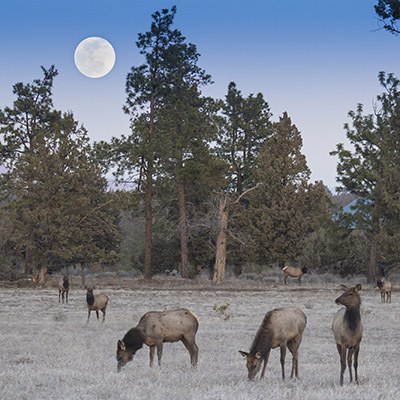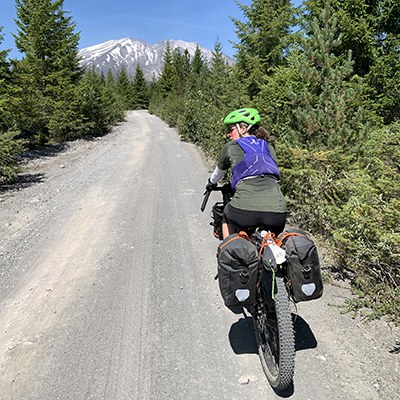Elk (Cervus elaphus) have captivated the human spirit for as long as we’ve inhabited North America. Native American artifacts from British Columbia all the way to Maine depict our reverence for the majestic wapiti (another term for elk from the Shawnee for “white rump”). Of the twenty-two recognized subspecies worldwide, four are found in North America and two of these inhabit Oregon—Roosevelt elk and Rocky Mountain elk. Roosevelt elk have the larger body of the two (males are 700-1,100 pounds) and are found in most of western Oregon. Rocky Mountain elk are smaller in body, but have the largest antlers of all elk, weighing up to 40 pounds! They are found in most of eastern Oregon. Informally, the border between the two subspecies in Oregon is considered to be US-97 but the two intermingle in the east Cascades and cross-breeding occurs with some hybrid elk called, Cascade elk.
Beginning every spring, bulls (male elk) that are at least a year old begin growing a new set of antlers (or rack). Cows (female elk) do not grow antlers. For most of summer, the antlers are covered with a velvety skin flush with blood vessels that provide nutrients to the rapidly growing solid bone underneath. Antlers can grow over an inch per day and are the fastest growing animal tissue known to exist! In late summer, a bull rubs his head against objects to shed the velvet, leaving behind the hardened rack. He will sport this new rack until mid- to late-winter when hormonal changes cause the antlers to fall off. As the bull matures year over year, the size and overall mass of his rack increases. A mature bull can grow a rack that is up to five feet wide! Scientists estimate that growing antlers costs the bull as much energy as that which a cow expends to gestate a calf.
Where do they get all of this energy? Elk are opportunistic vegetarian ungulates (hoofed mammals) that require on average approximately three pounds of forage (such as grasses, leaves, young plant shoots, bark, pine needles, and lichen) per 100 pounds of body weight per day. This can be a challenge in wintertime, even when elk follow seasonal migration routes from the deep snow of the mountains toward valleys in search of food. When spring rolls around, it’s catch-up time and elk spend around 13 hours per day foraging.
Elk travel in herds segregated by sex, with the bulls in bachelor herds sparring in summertime to determine rank. When the mating season (or rut) begins in September, a dominant bull uses a vocalization called bugling to simultaneously alert other bulls to his presence and also summon cows to gather around him into a “harem.” The bull busies himself marking territory, fighting off challenges from other bulls, and mating with all the cows in his harem, until around October when the harems dissolve and bulls part ways from cows again. As you might guess, the mating process can take a toll on a bull elk, resulting in a loss of up to 20 percent of his body weight (more time maintaining dominance means less time for eating) and injuries from fighting—both of which translate to increased risk of mortality after the rut.
For several weeks in late May and early June, pregnant cows will all return to their preferred calving grounds to give birth. This synchronized reproduction within a relatively short timeframe is a defensive adaptation that increases the odds of calves’ survival. It’s easier for predators to find and kill more calves when they are afforded a generous timeline to do it.
Calves and older infirm elk are the most vulnerable to predation by wolves, coyotes, mountain lions, and bears. A healthy adult elk relies upon speed and safety in numbers as survival strategies. Elk can maintain speeds of 30 miles per hour for extended periods of time so they are often able to outrun or outlast a predator in pursuit. They are also very adept swimmers that are comfortable in water, often having to cross deep rushing rivers as part of their migration routes. They are protected from frigid waters by their body fat and insulating hollow hairs that trap body heat.
One of the biggest threats to elk today isn’t natural predation, however. It is habitat loss and defragmentation. Logging and certain forest management practices diminish or destroy forest understory that the elk rely upon for forage, migration routes are interrupted by road construction or other structures, and winter foraging grounds are supplanted by housing developments.
Spending any time on protected lands in Central Oregon increases your chances of being lucky enough to spot elk. Always respect seasonal trail closures (such as Middle Flagline outside of Bend, to allow cows to calve their babies in a stress-free environment) and if you do spot a herd, always observe from afar. Thirty miles per hour is faster than it seems, especially when the pointy end is directed at you!
Sources:
-
US Forest Service Fire Effects Information System: Cervus elaphus
-
Ballard, Jack. Elk. Guilford, Connecticut, Morris Book Publishing, 2012.
-
Gish, Melissa. Elk. Mankato, Minnesota, Creative Education and Creative Paperbacks, 2018.
 Sarah Graham is an Oregon State Certified Master Naturalist who spends her free time mountain biking, trail running, talking to plants, and learning about all things nature.
Sarah Graham is an Oregon State Certified Master Naturalist who spends her free time mountain biking, trail running, talking to plants, and learning about all things nature.


